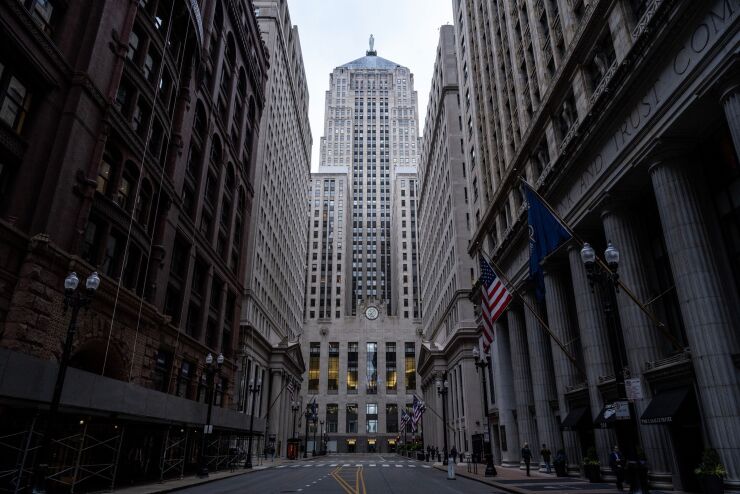(Bloomberg) -- Bond investors have punished banks with heavy exposure to commercial real estate, potentially adding even more pressure to the lenders' profits as Wall Street scrambles to assess how widely pain in property debt will spread through the financial system.
Banks with high levels of commercial real estate exposure tend to have bonds that trade at relatively wider spreads, according to an analysis by Barclays Plc credit strategists led by Dominique Toublan. In some cases, spreads on those bonds have been widening, even as investors have broadly piled into financial industry bonds in pursuit of higher-yielding securities.
Barclays' Toublan wrote in an email that commercial real estate-related angst explains about 80% of issuer-level spreads in the US investment-grade debt market, with lenders with lower exposure generally trading tighter. The differentiation in pricing underscores how investors are being selective as they snatch up bonds, a factor that could lift funding costs for banks already under pressure from setting aside money for potential real estate losses.
"At first, everybody just sold everything and asked questions later," Invesco's head of North America investment grade and senior portfolio manager Matt Brill said, citing last March when the collapse of Silicon Valley Bank triggered a selloff, widening bank bond spreads. "Now, they're finding out that there are some regionals that are better positioned than others."
Some of the regional lenders with portfolios weighted toward underperforming commercial real estate markets include Bank OZK, Valley National Bancorp and Webster Financial Corp., according to Morgan Stanley. None of the trio of banks responded to requests for comment from Bloomberg News.
Barclays says that Webster has commercial real estate exposure equal to more than 250% of its capital. The Stamford, Connecticut-based bank has bonds due 2029 that traded at spreads of nearly 200 basis points, or 2 percentage points. Those spreads have been widening since late January.
In contrast, Fifth Third Bancorp has commercial real estate exposure equal to less than 75% of its capital, according to Barclays. Its 2030 bonds trade at 148 basis points as of March 4, according to Trace, and its spreads have been narrowing. Both banks are rated in the same BBB tier.
In the US, smaller banks are relatively more exposed to commercial property: They have more than two thirds of the commercial real estate loans in the banking system, despite having about a third of the assets, according to data from the Federal Reserve.
Bank exposure to commercial real estate has been in focus for investors since at least January, when New York Community Bancorp shocked shareholders by slashing its dividend and bolstering reserves for troubled loans. In late February, the lender said it found "material weaknesses" in how it tracks loan risks.
Concerns about real estate exposure have hit banks in nations as far flung as Germany and Japan. The fallout from property trouble stands to reverberate widely, but to Sonali Pier, a high-yield and multi-sector credit portfolio manager at Pacific Investment Management Co., not all commercial real estate is the same, and bondholders should buy accordingly.
"We do find investment-grade financials to be attractive," said Pier. "In fact, there are some aspects at the top of the capital structure — like triple A, hotel and industrial data centers — that can be attractive."
It will likely take years for the cycle around commercial real estate to play out, which means bondholders have time to find "value opportunities," according to Invesco's Brill.
"None of this is happening overnight in terms of the commercial real estate losses," said Brill. "It's a slow bleed that works its way through the market and you just have to be one step ahead looking under the hood for banks that are adequately reserved."
NYCB
On Friday, Fitch Ratings cut NYCB's credit below investment-grade and Moody's Investors Service, which already had a junk rating on the bank, lowered it even further.
NYCB's floating-rate notes due 2028 fell more than 8 cents on the dollar to a record low of 70 cents on Monday, according to pricing source Trace. The notes traded at 83.25 cents on Feb. 27.
It's indicative of an "idiosyncratic" problem at NYCB rather than evidence of a broader industry contagion, according to Bloomberg Intelligence's Arnold Kakuda.
"Its management's credibility that's at issue," Kakuda said in a phone interview. "Other regional banks are better prepared," he added, referring to looming regulatory requirements that would have banks boost their capital cushions to protect against insolvency.
"Any bank that has a concentrated loan book, if it has outsized exposures, those banks will trade with more volatility," said Pranay Subedi, a credit research analyst covering the US banking sector for T. Rowe Price Group Inc. "The wider starting level of spreads reflects the fact that it's going to take a long time for the commercial real estate issue to play out."
(Updates with headlines at the bottom of story)
More stories like this are available on
bloomberg.com





